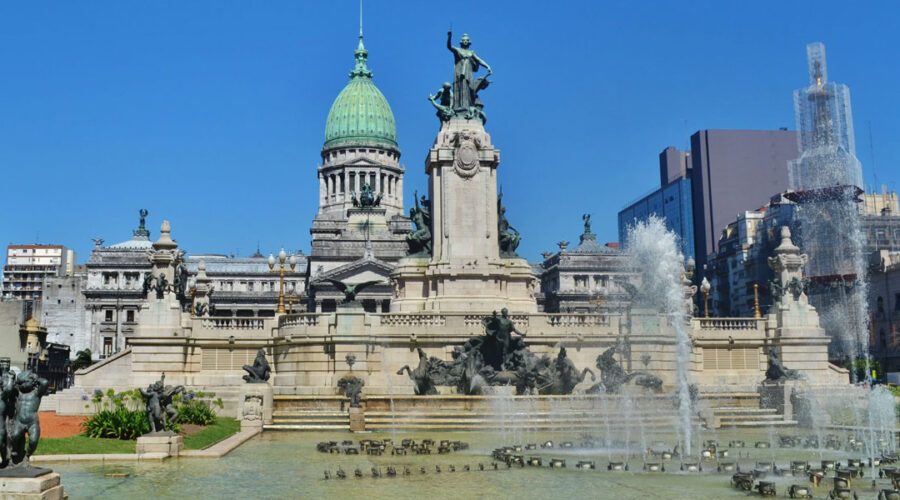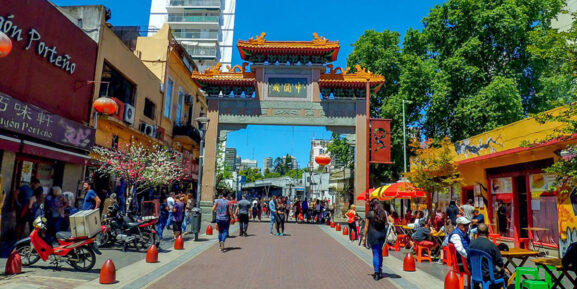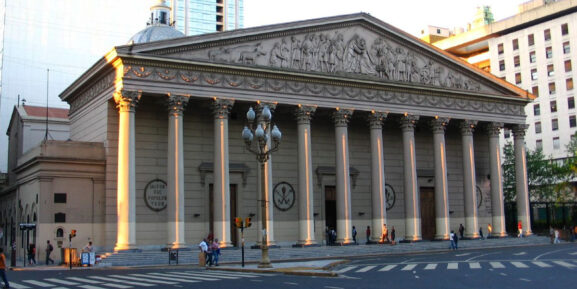Monuments of Buenos Aires
Monuments of Buenos Aires, a path through the most important historical monuments of the city, visiting the most popular neighborhoods.
Buenos Aires, in addition to being a huge city, has an infinite number of attractions, activities and architecture to admire, enjoy and learn about!
Within the wonders that adorn the city and enhance its beauty, are the historical monuments. Several of them were mere gifts received from neighboring countries or friends, others are an icon that represents the neighborhood where they are located and many others were built as a tribute to certain fundamental heroes in the history of Argentina.
We will enter this world, touring each neighborhood, so you can get to know the Monuments of Buenos Aires:
PALERMO
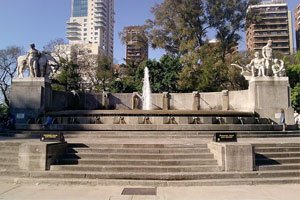 Agricultural Wealth Fountain
Agricultural Wealth Fountain
In the framework of the Argentine centenary, Germany decided to give this fountain as a gift in gratitude that Argentina has received immigrants from this country in its territory. It was installed in 1910 and was inaugurated 8 years later. The main figures represent Agriculture and Livestock, fundamental pillars of development and the Argentine economy. You will find this fountain in Armenia Plaza.
The Magna Carta and the Four Argentine Regions
It is popularly known as the “Monument of the Spanish”, since it was a donation from that community in 1910, in full celebration of the Argentine Centennial. It is located at the intersection of Del Libertador and Sarmiento Avenues. Its base is made up of allegories to the Río de la Plata, Chaco and La Pampa, Work and The Andes.
General Justo José of Urquiza
As a tribute to one of the most outstanding heroes in the history of Argentina, it was inaugurated in 1958 on Av. Sarmiento and Figueroa Alcorta. It is a sculpture built in granite and bronze, whose base denotes the General Constituent Assembly in bas-relief, thanks to which our country achieved its independence.
The Immortal Grandfather
In this case, it is a monument that commemorates and honors General José of San Martín, who was the hero of Argentine history. Here, he is remembered in his final moments, in civilian clothes and surrounded by his beloved granddaughters. You will find it at the intersection of Av. Mariscal Castilla and Aguado.
Here we tell you everything you can do in Palermo!
RECOLETA
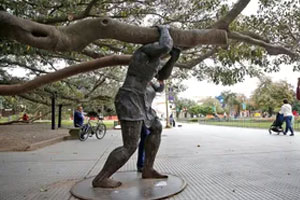 The Atlas of Recoleta
The Atlas of Recoleta
It is a truly imposing figure, which was made using auto parts and is located in the middle of San Martín of Tours Square. You will be able to find it between Posadas and Bioy Casares streets. It has a total weight of 250kg and will catch your attention, since it is in charge of sustaining one of the oldest trees in Buenos Aires: a Gomero that was planted in 1781!
Torcuato de Alvear
At the intersection of Alvear, Pueyrredón and Del Libertador Avenues, in the middle of Alvear Plaza, you will find this tribute to the first mayor of the City of Buenos Aires. This monument was inaugurated in 1900 and has bas-reliefs that represent and commemorate several important events in history. His figure is made of bronze and symbolizes the “Glory”.
From France to Argentina
This is another example of a gift made by the French community and was inaugurated in 1910, before the Centenary of the May Revolution. Given its nationality, we can deduce its location: in the middle of France Square! An immense green space, very popular among the people of Buenos Aires and home to various meetings, recitals and crafts.
Floralis Generic
It is one of the monuments that generates the most curiosity. With a unique size and structure, it will catch your attention without hesitation! It is basically a giant flower, located in the middle of the lake, surrounded by gardens. It has a system for opening its petals through sunlight, so you will see that it opens in the morning and closes at night.
Here we tell you everything you can do in the Recoleta neighborhood!
PUERTO MADERO
Monumental Fountain The Nereids
Declared an Asset of National Historic Interest in 1997, it is a very attractive icon that stands in front of the Ecological Reserve. Made of marble and pink granite, its main figure is the Goddess Venus, accompanied by Nereids and Tritons. This fountain will invite you to go around it, turning around it, to be able to enjoy its spiral wrap.
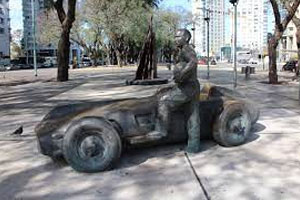 Juan Manuel Fangio
Juan Manuel Fangio
One of the most successful and recognized racers in motoring history, it has a monument on Boulevard A. Villaflor. It was installed in 2005 and is a life-size figure of Fangio with his Mercedes-Benz W196, made in bronze.
Tango Monument
In this case, it is a sculpture made of steel, 3 meters high and in the shape of a Bandoneon, a fundamental instrument for the history of Tango. You will find it on Azucena Villaflor 501 Street.
Monument to Spain
To symbolize the union between Argentina and the Spanish people, this sculpture was inaugurated in 1937 on Av. España towards the end of South Coast. It has 27 bronze characters on a dragon red granite base. Among which stands out Christopher Columbus, discoverer of America. At the top you will see a seated woman and a standing young woman, representing Spain and Argentina.
SAN TELMO
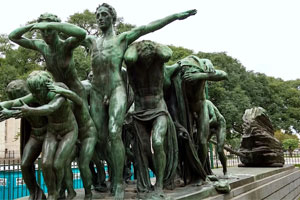 Sing to work
Sing to work
In 1907, this monument was inaugurated as an expression of the effort of work, the hope of the common struggle and a clear expression of liberation. It has 14 bronze figures that drag a giant stone and is located on Paseo Colón street, in the Coronel Manuel of Olazábal square.
Monument to International Cordiality
In the middle of Lezama Park, you will find this monument, a gift from the Government of Uruguay. It is a small-sized vessel, with a large bronze column and protruding features that recount and portray the founding of the city. At the top, a figure stands as a symbol of “The Offering”.
To find out everything you can do in San Telmo, follow this link!
RETIRO
Monument to General José of San Martín and the Armies of Independence
Another monument that honors General José of San Martín. Located in the San Martín Square, it represents, in addition to the liberator of Argentina, four important milestones of the independence of America: the Taking of Montevideo, the Crossing of the Andes, the Proclamation of the Independence of Peru and the Battle of Salta. All victorious events that were achieved with effort and struggle. The monument is made of bronze, on a polished red granite base. You will notice that it is a space where many people rest a bit or take photos to remember, since its size is impressive.
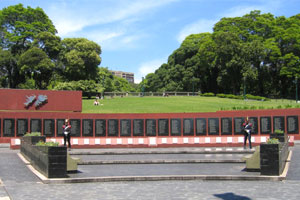 Monument to the Fallen of Malvinas
Monument to the Fallen of Malvinas
In 1990, this tribute was inaugurated, with 25 black marble plates that highlight the 649 names of those who fought and perished in the war against England in 1982. Under these plates, there are the 23 coats of arms of the provinces that make up Argentina, in addition to the Coat of Arms of the City and the National Coat of Arms. In its upper part, there is the image of the Malvinas Islands and, every day, two soldiers guard this place. In turn, you will see a torch that stays lit all the time. You will also find it inside San Martín Square, on Av. Del Libertador.
DOWNTOWN
Pyramid of May
In this case, it is the first patriotic monument that Buenos Aires has and stands in the middle of the renowned May Square. Nucleus of enormous historical events, this pyramid commemorates the first anniversary of the May Revolution. It was installed in 1811, but was reformed in 1856. Historical Site, along with the entire area that surrounds it.
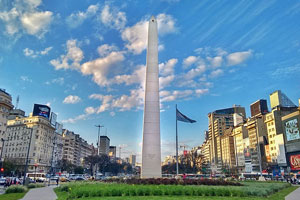 Obelisc
Obelisc
National Historical Monument, emblem of the city and where the Argentine flag was raised for the first time. It is located between Corrientes and 9 of July Avenues. It was inaugurated in 1936, on the fourth centenary of the first foundation of Buenos Aires.
Monument to the Two Congresses
In the middle of Congress Square, just in front of the Congress of the Argentine Nation, you will find this monument, the result of the Centenary of the May Revolution. In 1914 it was inaugurated with a neoclassical design and making an allegory of the Argentine Republic: the figure is advancing, with a laurel branch in one hand and the other leaning on the guide of a plow. On the sides, two figures honor the National Assembly of 1813 and the Congress of 1816. A fountain represents and symbolizes the Río de la Plata.
We invite you to join our Free Tours around the city of Buenos Aires here, to learn much more!

